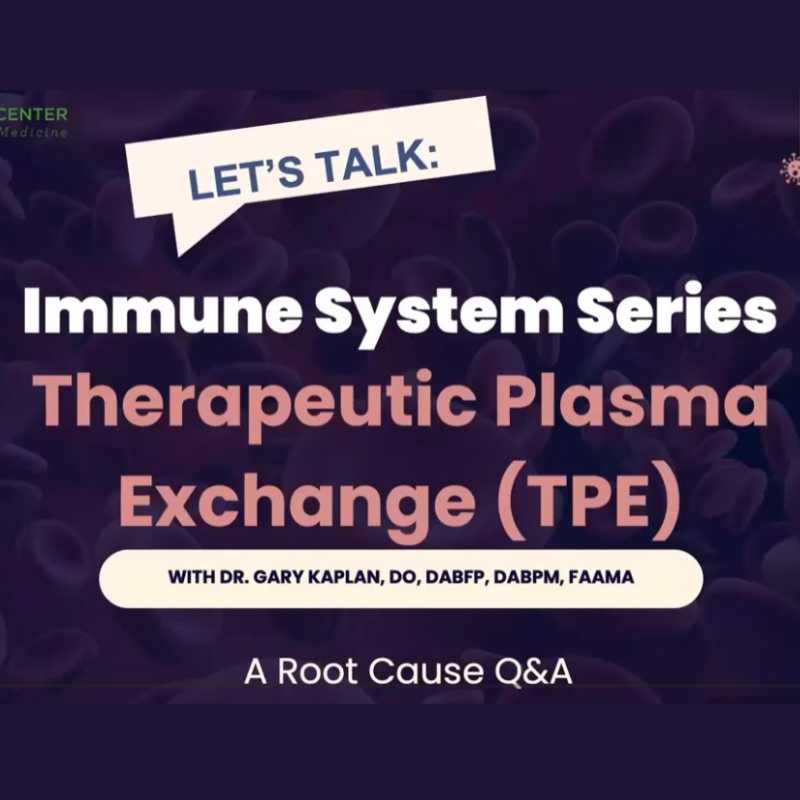
5 Ways We Can Keep Your Immune System Strong
December 10, 2025/by Kaplan Center
Want to Take Your Workout to the Next Level Next Year? These Tips Can Help
December 8, 2025/by Kaplan Center
Dr. Kaplan’s Dos and Don’ts of the Holiday Season
December 3, 2025/by Kaplan Center
Let’s Talk Webinar – A Root Cause Q&A
December 2, 2025/by Kaplan Center
Navigating Holiday Meals with Gut Issues: Simple Tips for a Comfortable Season
December 1, 2025/by Chardonée Donald, MS, CBHS, CHN, CNS, LDN
Craniosacral Therapy for TMJ | Say Goodbye to the Daily Grind
November 19, 2025/by Patricia Alomar, M.S., P.T.
From Compassionate Care to Personal Healing: A Letter to My Patients
November 18, 2025/by Kaplan Center
8 Steps to a Healthier Gut—and a Longer, Healthier Life
November 18, 2025/by Kaplan Center
Mid-Life Irritability & Fatigue Improved by Hormonal Balancing
November 13, 2025/by Lisa Lilienfield, MD
From Challenges to Change: Dr. Kaplan on Healthcare’s Biggest Challenges
October 29, 2025/by Kaplan Center
Overlooked Dangers of Mold Exposure and How to Stay Safe – Dr. Kaplan Talks to WUSA9
October 27, 2025/by Kaplan Center
Let’s ‘Fall’ Into Wellness: A Nutritionist-Approved Immune-Boosting Recipe for Cold and Flu Season
October 13, 2025/by Chardonée Donald, MS, CBHS, CHN, CNS, LDN
PANS/PANDAS – When Sudden Symptoms Signal Something More
October 9, 2025/by Kaplan Center
Beating Burnout, A Nutritionist’s Perspective
October 1, 2025/by Chardonée Donald, MS, CBHS, CHN, CNS, LDN
3 Things That Can Happen After Stopping GLP-1s
September 11, 2025/by Chardonée Donald, MS, CBHS, CHN, CNS, LDN
What Families Need to Know About COVID and Flu Season
September 3, 2025/by Kaplan Center
September is Pain Awareness Month
September 1, 2025/by Kaplan Center
Dr. Kaplan Spoke to Northern Virginia Magazine About COVID, Flu, and Immunity — Here’s What You Should Know
August 14, 2025/by Kaplan Center
“Why Do I Feel Like Crap?”: The Overlap Between Long COVID and Perimenopause
July 30, 2025/by Kaplan Center
Why People Are Turning to EMDR (and Why You Might Want to Too)
July 23, 2025/by Kaplan CenterAre you looking to improve your overall wellness?
Personalized care you can trust.
Our integrative, non-surgical treatment approach is highly successful in maintaining wellness and also treating chronic pain and illness. For more than 30 years, we have delivered superior, cutting-edge health care in the Washington, DC area.
QuickLinks
Contact Information
Tel: 703-532-4892
Fax: 703-237-3105
6829 Elm Street, Suite 300
McLean, Virginia 22101
Map It
Hours of Operation
Mon – Thu : 8 am – 5 pm, ET
Fri : 8 am – 12 pm, ET
7 Benefits of Stable Blood Sugar
/in Nutrition, Wellness/by Kaplan CenterDiabetes is a chronic medical condition characterized by high blood sugar levels as a result of your body’s inability to properly regulate insulin, the hormone responsible for controlling glucose levels. Diabetes is best managed with a proper diet, lifestyle changes, and in some cases, the use of medication such as insulin or oral hypoglycemic agents.
If you have Type 1 diabetes, your body does not produce insulin on its own. If you have Type 2 diabetes, your body doesn’t produce enough insulin or the cells become resistant to insulin’s effects. In both cases, this dysregulation of insulin levels can lead to periods of high and sometimes low blood sugar levels. This can negatively impact the body so maintaining stable blood sugar levels is essential for your overall health and well-being.
Kaplan Center’s approach to managing diabetes addresses all of the root causes that are driving your condition. In contrast to conventional medicine, our functional medicine approach emphasizes prevention through lifestyle and dietary modifications and promotes overall health and wellness. Please give us a call today, we can help.
Here are seven benefits of having a stable blood sugar
1 – Enhanced energy levels
When your blood sugar level is stable, your body can efficiently convert glucose into energy. This means you will be provided with a steady and constant energy supply throughout the day and reduce the amount of fatigue or sluggishness that you experience.
2 – Better weight management
It is important that you maintain a stable and healthy body weight with diabetes and having a stable blood sugar level can help. When your blood sugar remains steady, you’re less likely to experience intense hunger or cravings that can lead to overeating or making unhealthy food choices.
3 – Increased focus and concentration
Blood sugar imbalances can affect cognitive function, leading to difficulties in concentration and focus. In fact, Alzheimer’s disease, dementia, and cognitive impairment are now being dubbed by researchers as Type 3 Diabetes due to the strong link between insulin resistance and cognitive decline/impairment. Interestingly, this could also help explain why dementia patients always crave sweet things.
Because the brain is the most energy-demanding organ and uses one-half of all sugar (energy) in the body, stable blood sugar will not only help promote better brain function and improve mental clarity but will also help lower your risk of developing Alzheimer’s disease and dementia.
For more information on insulin resistance, its relationship with cognitive function, and strategies on how to stabilize your blood sugar, you can read the following articles by Dr. Lisa Lilienfield, “Pre-diabetes: Are You at Risk?” and “Addressing the Fear of Cognitive Decline & How to Be Proactive.”
4 – A reduction in the number of diabetes-related complications
Consistently high blood sugar levels are associated with long-term damage to various organs including the eyes, kidneys, heart, and nerves. By maintaining a stable blood sugar, your risk of these complications is reduced. This is important because the complications can be serious; complications include macular degeneration of the eyes, reduced kidney function, or issues affecting your nerves.
5 – Improved mood and mental well-being
Fluctuating blood sugar levels can lead to mood swings, irritability, and even anxiety. One study found that greater glycemic variability may be associated with a lower quality of life and negative moods. So, by maintaining stable blood sugar, you promote better emotional balance and overall mental well-being.
6 – Improved cardiovascular health
High blood sugar levels can damage your blood vessels and increase your risk of cardiovascular diseases such as heart attacks and strokes. A stable blood sugar can help you maintain a healthier cardiovascular system which reduces your risk of many life-threatening cardiovascular issues and heart disease.
7 – Enhanced overall health
Stable blood sugar levels can positively impact various aspects of your health such as supporting your immune function. This boosts your body’s ability to fight off infections and illnesses more effectively. Additionally, stable blood sugar is known to contribute to better sleep quality, hormonal balance, and overall longevity.
We are here for you, and we want to help.
Our goal is to return you to optimal health as soon as possible. To schedule an appointment please call: 703-532-4892 x2
References
https://hms.harvard.edu/news-events/publications-archive/brain/sugar-brain
https://www.ncbi.nlm.nih.gov/pmc/articles/PMC3317401/
https://www.ncbi.nlm.nih.gov/pmc/articles/PMC7246646/
These Yoga Poses Can Help Prevent Age-related Bone Loss
/in Bone Health, Wellness, Women's Health/by Kaplan CenterDr. Lisa Lilienfield explains how yoga is one of the best and safest ways to counteract age-related bone loss. The key to its benefits is that it uses both tensile (stretching) force and isometric, compressive (weight-bearing) force to stimulate the osteocytes (cells found in mature bone) to produce proteins and lay down new bone.
Yoga is something that anyone, of any age, can do anywhere; the benefits are many and risks few when done correctly.
Make sure to watch Parts 1 and 2 to learn a few simple poses you can try at home!
Yoga for Bone Health – Part 1 (Intro):
Yoga for Bone Health – Part 2 (Poses):
We are here for you, and we want to help.
Our goal is to return you to optimal health as soon as possible. To schedule an appointment please call: 703-532-4892 x2
Research Confirms This Ancient Practice Helps With Low Back Pain
/in Treatments/by Kaplan CenterWe are at a crossroads in the applications of yoga for modern medicine. Traditionally, yoga was designed to promote harmony within the body and with the natural world. Modern medicine is now acknowledging that this ancient approach of breath practices, movement, and meditation is proving beneficial for an issue that plagues many Americans: back pain.
If your smoke alarm sounded, imagine cutting the wires to the alarm instead of putting out the fire. This is what many of us are doing when it comes to our health.
Back pain remains a primary reason many Americans find themselves on over-the-counter NSAIDS and even prescription narcotics. As common as it is for us to want to cover up symptoms rather than address the root of the problem, it gets us nowhere, fast. We end up addicted to medications to help us get through the day (or night), experiencing side effects like heartburn and worse, all the while allowing the underlying problem to fester.
Research published in the Annals of Internal Medicine put yoga side by side with physical therapy (PT), one of the most widely prescribed treatments for low back pain, and found that yoga had “almost the same amount of improvement in pain and activity limitation over time” as PT.
However, patients are strongly encouraged to consult a physician before engaging in a yoga routine to establish limitations and avoid further injury. The research also gives hope that insurance companies will more widely offer yoga as a covered treatment.
Yoga eases back pain first by increasing awareness.
When our bodies are in pain, we tend to “check out” – we don’t want to feel it. However, the body is full of wisdom when we stop to listen to it. Inherent in any imbalance is the mechanics of its healing. As you tune into your body, you gain a natural understanding of what needs strengthening, what needs to stretch, and what needs to relax.
We start by deepening the breath and learning to direct the breath into the back and hips. Beginning with gentle movements, we increase the flow of energy into areas of the body weakened by pain and lack of use. Health is flow. Imagine what a stagnant pond looks like; all sorts of microbes and bacteria can fester there. Now imagine a clear flowing stream; illness and pain can’t take hold as easily when energy is flowing. It is important to focus both on strengthening and stretching – many people over-stretch when in pain. However, the key for back pain is increasing stability; this means engaging your core, back, and hip muscles while also allowing them to lengthen.
Lastly, meditation is key.
They call back pain the “new ulcer” — a societally acceptable physical manifestation of stress, the way ulcers used to be. As with any stress-related illness, the key is learning to calm and soothe the nervous system and to increase your love and appreciation of yourself and of life. Meditation helps to press the pause button. It offers a choice as to where you place your attention — I can choose to focus on the pleasant feeling of breath in my body right now, rather than running a mental movie in my head about something that is going (or not going) to happen tomorrow. As our present-moment awareness grows, the tension in our bodies dissolves.
Yoga is a systematic approach to health and happiness that has an infinite variety of applications. May you discover the power of yoga to support you on your journey toward health.
* Before starting any new exercise routine, patients should discuss potential limitations with a physician.
We are here for you, and we want to help.
Our goal is to return you to optimal health as soon as possible. To schedule an appointment please call: 703-532-4892 x2
This article was originally published in June 2017. It was reviewed and updated in September 2023.